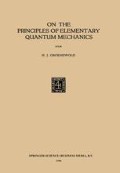Summary
Our problems are about
α the correspondence a ←→ a between physical quantities a and quantum operators a (quantization) and
β the possibility of understanding the statistical character of quantum mechanics by averaging over uniquely determined processes as in classical statistical mechanics (interpretation).
α and β are closely connected. Their meaning depends on the notion of observability.
We have tried to put these problems in a form which is fit for discussion. We could not bring them to an issue. (We are inclined to restrict the meaning of α to the trivial correspondence a → a (for lim ħ → 0) and to deny the possibility suggested in β).
Meanwhile special attention has been paid to the measuring process (coupling, entanglement; ignoration, infringement; selection, measurement).
For the sake of simplicity the discussion has been confined to elementary non-relativistic quantum mechanics of scalar (spinless) systems with one linear degree of freedom without exchange. Exact mathematical rigour has not been aimed at.
Access this chapter
Tax calculation will be finalised at checkout
Purchases are for personal use only
Preview
Unable to display preview. Download preview PDF.
References
J. v. Neumann, Mathematische Grundlagen der Quantenmechanik, Berlin 1932; New York 1943.
H. Weyl, Z.Phys. 46, 1, 1927; Gruppentheorie und Quantenmechanik, Leipzig 1928.
W. H. Furry, Phys. Rev. (2) 49, 393, 476, 1936.
E. Schrödinger, Proc. Camb. Phil. Soc. 31, 555, 1935; 32, 446, 1936; Naturw. 23, 807, 823, 844, 1935.
A. E. Ruark, Phys. Rev. (2) 48, 446, 1935.
L. F. v. Weizsäcker, Z. Phys. 70, 114, 1931.
A. Einstein, B. Podolsky and N. Rosen, Phys. Rev. (2) 47, 777, 1935.
N. Bohr, Phys. Rev. (2) 48, 466, 1935.
G. Temple, Nature 135, 957, 1935.
H. Fröhlich and E. Guth, G. Temple, Nature 136, 179, 1935.
R. Peierls, Nature 136, 395, 1935.
E. Wigner, Phys. Rev. (2) 40, 749, 1932.
Rights and permissions
Copyright information
© 1946 Springer Science+Business Media Dordrecht
About this chapter
Cite this chapter
Groenewold, H.J. (1946). On the Principles of Elementary Quantum Mechanics. In: On the Principles of Elementary Quantum Mechanics. Springer, Dordrecht. https://doi.org/10.1007/978-94-017-6065-2_1
Download citation
DOI: https://doi.org/10.1007/978-94-017-6065-2_1
Publisher Name: Springer, Dordrecht
Print ISBN: 978-94-017-5719-5
Online ISBN: 978-94-017-6065-2
eBook Packages: Springer Book Archive

